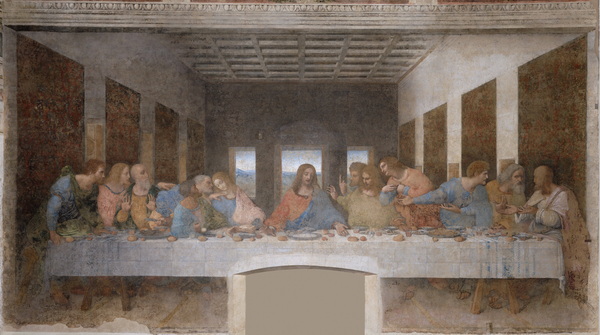
The Last Supper, a renowned masterpiece by Leonardo da Vinci.
Here is a detailed introduction following the format similar to that of the Mona Lisa:
1. Commission and Subject
- Commission: It was commissioned by Ludovico Sforza, the Duke of Milan, for the refectory of the Santa Maria delle Grazie convent in Milan, Italy. The project was part of a larger renovation of the convent complex.
- Subject: The painting depicts the scene of Jesus Christ’s last meal with his twelve apostles before his crucifixion, as described in the Christian Gospels. It captures the moment when Jesus announces that one of his apostles will betray him, resulting in a range of emotional and dramatic reactions among the figures.
2. Leonardo’s Motives
Leonardo da Vinci was eager to explore human emotions and group dynamics through his art. In The Last Supper, he masterfully uses body language, facial expressions, and gestures to convey the shock, disbelief, and concern of the apostles. He also experimented with new techniques. Instead of using the traditional fresco method (which involves painting on wet plaster), he developed a new technique that allowed for more detailed and nuanced color work. However, this technique proved to be less durable over time.
3. Historical and Cultural Context
- Time of Creation: It was painted between 1495 and 1498, during the High Renaissance. This period was characterized by a flourishing of art, science, and culture, with a strong emphasis on humanism. The painting reflects the humanist ideals by presenting the apostles as individual, three – dimensional characters with distinct personalities, rather than just as generic religious figures.
- Influence: The composition of The Last Supper, with Jesus at the center and the apostles arranged in groups of three on either side, has had a profound influence on Western art. It established a new standard for representing this biblical scene and inspired countless artists in subsequent centuries.
4. The Painting’s Journey
- Initial Condition and Deterioration: Due to Leonardo’s unorthodox painting technique, the work began to deteriorate soon after its completion. By the 16th century, it was already showing signs of damage, such as flaking paint.
- Restoration Efforts: Over the centuries, numerous restoration attempts have been made. During the French occupation of Milan in the late 18th century, the convent was used as a stable, and the painting was further damaged. In the 19th century, some restoration work was carried out, but it was not until the 20th – century restoration (which lasted from 1978 to 1999) that a more comprehensive and scientific approach was taken to preserve the painting.
- Current Status: Today, The Last Supper is one of the most famous and visited artworks in the world. It is still located in the refectory of the Santa Maria delle Grazie in Milan. The convent and the painting are protected as a UNESCO World Heritage Site, and strict access regulations are in place to preserve the fragile artwork. Only a limited number of visitors are allowed to enter the refectory at a time, and they must follow specific rules to minimize the impact on the painting’s environment.
FOR the arkwork of “The Last Super“, we have SUPER HD Version, the definition is 33000 X 18445, Probably the highest-Resolution that you could find online.
